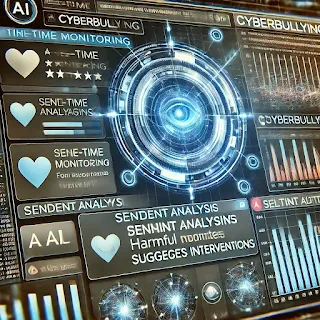How Artificial Intelligence Is Revolutionizing Cyberbullying Detection and Prevention
- Get link
- X
- Other Apps
How Artificial Intelligence Is Revolutionizing Cyberbullying Detection and Prevention
Table of Contents
- Introduction
- Understanding Cyberbullying in the Digital Age
- The Role of AI in Detecting Cyberbullying
- Key AI Technologies and Approaches
- Implementing AI-Powered Prevention Strategies
- Challenges and Limitations
- Future Developments
- Conclusion
1. Introduction
Cyberbullying has become a serious issue in today’s digital landscape, affecting millions worldwide, especially young users. According to the Pew Research Center, 41% of Americans have experienced online harassment, making it one of the most pressing concerns in the modern internet era.
Unlike traditional bullying, cyberbullying can occur 24/7, spread instantly, and allow perpetrators to remain anonymous, making it harder to combat. Traditional monitoring methods—such as manual moderation and user reporting—have struggled to keep pace with the sheer volume of digital interactions. However, artificial intelligence (AI) is now transforming the fight against cyberbullying by offering real-time detection, analysis, and prevention strategies.
2. Understanding Cyberbullying in the Digital Age
Cyberbullying manifests in various forms, including:
✅ Sending threatening or harassing messages
✅ Spreading false rumors or misinformation
✅ Sharing private or embarrassing content without consent
✅ Excluding individuals from online communities
✅ Impersonation and identity theft
The Consequences of Cyberbullying
The impact of cyberbullying can be devastating, often leading to:
🔹 Mental health issues such as anxiety, depression, and low self-esteem
🔹 Academic decline due to stress and reduced focus
🔹 Social withdrawal and isolation
🔹 Severe cases, including self-harm or suicidal thoughts
With online interactions becoming an integral part of life, addressing cyberbullying effectively requires automated and scalable solutions, which is where AI plays a crucial role.
3. The Role of AI in Detecting Cyberbullying
Artificial intelligence is transforming cyberbullying detection through:
🔍 Real-Time Monitoring
AI can analyze vast amounts of online content across multiple platforms, detecting harmful interactions instantly before they escalate.
🧠 Pattern Recognition
Machine learning algorithms detect subtle bullying behaviors, even when explicit offensive words are not used.
🗣️ Natural Language Processing (NLP)
AI-powered NLP models can analyze:
- Sentiment and tone of messages
- Sarcasm and coded language used in bullying
- Cultural differences and slang to improve detection accuracy
By leveraging these capabilities, AI ensures that cyberbullying is flagged and addressed more effectively than traditional methods.
 |
| AI-Powered Cyberbullying Detection System |
4. Key AI Technologies and Approaches
Machine Learning Models
📌 Supervised Learning: AI models are trained on labeled datasets containing real-world examples of cyberbullying to identify similar patterns in new conversations.
📌 Unsupervised Learning: AI can detect new bullying trends without requiring human-labeled data, making it adaptive to evolving online threats.
Deep Learning Networks
🤖 Neural Networks analyze text, images, and user behavior to identify hidden patterns of harassment, even when bullies use indirect or disguised language.
Sentiment Analysis
💬 AI evaluates the emotional tone of messages to determine:
✅ Negative sentiment patterns
✅ Escalation of online conflicts
✅ Contextual intent of statements
Content Classification
📝 AI classifies online content based on:
✔ Severity of threat (mild, moderate, or severe harassment)
✔ Type of bullying (verbal abuse, misinformation, social exclusion)
✔ Required intervention level (alert moderators, warn users, or remove content)
These AI-driven strategies enable more accurate and context-aware cyberbullying detection.
5. Implementing AI-Powered Prevention Strategies
🔹 Platform Integration
Social media platforms and online communities can integrate AI to:
✔ Automatically filter offensive content
✔ Monitor user behavior trends for early signs of bullying
✔ Issue real-time warnings before harmful content is posted
🔹 User Protection Features
AI can empower users with:
✔ Customizable privacy settings to prevent online abuse
✔ Automated blocking suggestions based on AI-detected threats
✔ Safe space creation for vulnerable individuals
 |
| AI Moderation in Social Media Platforms |
🔹 Educational Initiatives
AI-driven tools can help in:
📌 Identifying at-risk users and offering mental health resources
📌 Sending real-time guidance on cyber etiquette
📌 Tracking the effectiveness of intervention measures
🔹 Intervention Systems
Upon detecting cyberbullying, AI can:
🚫 Remove harmful content immediately
⚠ Issue warnings or temporary suspensions to offenders
📢 Recommend support resources for affected users
🔔 Notify authorities if threats escalate to real-world danger
By implementing these AI-driven strategies, online platforms can proactively prevent cyberbullying rather than merely responding to it.
6. Challenges and Limitations
While AI offers powerful solutions, it also faces several challenges:
🔸 Technical Challenges
❌ False Positives: AI might flag harmless content as bullying, frustrating users.
❌ Context Understanding: Detecting sarcasm, cultural nuances, and inside jokes remains difficult.
🔸 Ethical Concerns
🔍 Privacy Issues: AI must balance monitoring content without violating user privacy.
⚖ Algorithmic Bias: AI models can unfairly target certain groups if not trained on diverse datasets.
To overcome these challenges, continuous AI improvement and human moderation are necessary to ensure fair and accurate cyberbullying detection.
7. Future Developments
🚀 Emerging AI Technologies
🔹 Advanced Language Models: AI will better understand complex contexts and subtle harassment.
🔹 Behavioral Prediction Models: AI could predict potential cyberbullying incidents before they occur.
🌐 Cross-Platform Collaboration
🔹 Unified Cyberbullying Response Systems: Platforms may share data and threat signals for better detection.
🔹 International Cooperation: Global organizations can standardize AI-powered solutions to combat cyberbullying effectively.
As AI continues to evolve, these advancements will further enhance the effectiveness of cyberbullying detection and prevention.
8. Conclusion
Artificial intelligence is revolutionizing the way we combat cyberbullying by offering real-time detection, advanced pattern recognition, and automated prevention strategies.
While AI is not perfect, continued innovation, human oversight, and cross-platform collaboration will help create safer online environments for all users.
By integrating AI-driven tools into social platforms, educational systems, and online communities, we can take a proactive approach to eliminating cyberbullying and protecting vulnerable individuals from online harm.
References
- Pew Research Center (2024) – "Online Harassment 2024 Report"
- National Crime Prevention Council (2023) – "Cyberbullying Prevention Strategies"
- Journal of Cybersecurity (2024) – "AI Applications in Online Safety"
- IEEE Transactions on Artificial Intelligence (2023) – "Machine Learning for Cyberbullying Detection"
- American Psychological Association (2024) – "Digital Safety and Mental Health"
- Get link
- X
- Other Apps




Comments
Post a Comment